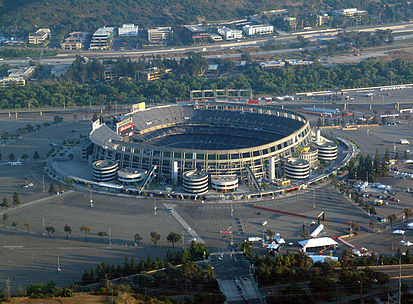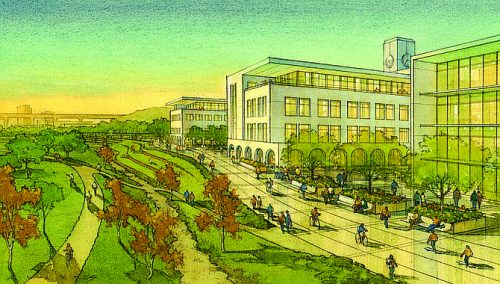When San Diego voters voted to reject the funding of a new stadium for the San Diego Chargers in 2016, the news for the next few days revolved around the inevitable relocation of the city’s 56-year old NFL franchise. As a result, though, a lesser known second issue presented itself to the people of San Diego: what’s next for the home of the San Diego Chargers, Qualcomm Stadium?
 The Stadium, which was renamed SDCCU Stadium in September 2017, has long been a staple of the city. Built in 1967, the stadium was first named San Diego Stadium and hosted the Chargers in their inaugural season. Since then, the stadium has hosted numerous famous concerts and housed other sports teams such as the San Diego Padres of baseball and the San Diego Sockers of soccer. The stadium is well located, less than a 15-minute drive from the populous Downtown San Diego district and along the green line for public transportation.
The Stadium, which was renamed SDCCU Stadium in September 2017, has long been a staple of the city. Built in 1967, the stadium was first named San Diego Stadium and hosted the Chargers in their inaugural season. Since then, the stadium has hosted numerous famous concerts and housed other sports teams such as the San Diego Padres of baseball and the San Diego Sockers of soccer. The stadium is well located, less than a 15-minute drive from the populous Downtown San Diego district and along the green line for public transportation.
Unfortunately, the stadium has a lot of issues that goes beyond redeveloping and renovating it for football purposes[1]. The biggest issue has to do with the fact that the stadium was not built for just football. The initial use of the stadium was for both baseball and for football, so the seat layout, which has retained its 1960s build , are not well laid out for football purposes. There are also a lot of deferred repairs and maintenance, nearly $80 million that still have not been addressed to simply keep the stadium functioning as-is. As a result, architects, government officials, and other parties have estimated the cost of renovating the stadium to be about the same as replacement cost. As a result, there has been two large scale proposals for redeveloping the site. One is from San Diego State University (SDSU), and the other is from FS Investors.
SDSU’s plans, estimated to cost $3 billion, call for the construction of a new 35,000 seat stadium, 1.6 million square feet of campus/tech office space, 4,500 housing units, two hotels, about 95,000 square feet of retail space, more than 85 acres of open space, and four miles of hiking and bike trails[2]. The stadium, at 35,000 seats, will suit current needs for the SDSU Aztec’s football team as well as have an option be expanded to a larger stadium should an NFL team decide to relocate to San Diego down the line. The university plans to pay for the stadium without tapping into student fees or state grants, and developers will fund the residential and commercial aspects of the project.[3]

FS Investors, on the other hand, plans to head towards the Major League Soccer direction with its stadium. FS Investor’s $4 billion proposal includes a 23,500-seat professional soccer stadium that could be expanded to 33,500 seats, 4,800 housing units, two hotels, about 3.1 million square feet of office and retail space, two hotels and 60 acres of parkland. FS Investors does not plan to pay for their project with public money but rather secure a 99-year from the city and buy the land in phases over time.
While both bids seem very similar on paper when it comes to the final project, the structures for the transactions are very different. The SDSU plan calls for all 166 acres of the land to be purchased at fair-market value, with the stadium development paid for by revenue bonds.[4] These bonds will then be paid back from site revenues that will not be tax-exempt. Under the FS Investor SoccerCity plan, though, only 79-acres will be outright purchased at a price of $82 million, with the remaining land leased to the developer. FS Investors would then drive the selling and leasing of the rest of the site to the school, with a caveat that the stadium they plan to build will not be used for football purposes but rather only for the soccer team.
So what is next for the two parties? Both have earned a spot on the upcoming November ballot, which will seal their fate. The winner, provided they get over 50% of the votes, will earn the right to move forward in their development process. So, come November, San Diego citizens will have the choice to make- football, or soccer?
[1] https://www.voiceofsandiego.org/topics/land-use/stadium-players-largely-agree-on-one-thing-qualcomms-beyond-saving/
[2] https://www.sdbj.com/news/2018/feb/15/sdsu-stadium-plan-headed-november-ballot/
[3] http://www.sandiegouniontribune.com/business/growth-development/sd-fi-sdsu-mission-valley-plan-stadium-20171129-story.html
[4] http://www.sandiegouniontribune.com/business/growth-development/sd-fi-sdsu-mission-valley-plan-stadium-20171129-story.html
